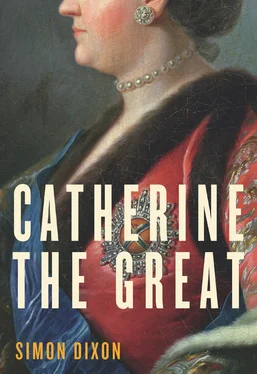When it came to opulence, there was no question which of these Courts had set the standard. It can hardly have been a coincidence that the official press chose the eve of the announcement of Catherine’s nuptials to report on the festivities at Versailles following the Dauphin’s marriage to the Spanish Infanta. 77‘Never has finer magnificence been witnessed than during those three days,’ insisted the St Petersburg News on 15 March. ‘Diamonds worth 250 million were on display, not counting the crown, which is estimated at 70 million. The attire of the Dauphin and his wife alone stretched to 45 million.’ 78To allow them to prepare in suitable style, the leading Russian statesmen (known collectively as the generalitet because they ranked with army generals on the top four ranks of Peter the Great’s Table) were advanced a full year’s salary, normally paid in instalments every four months. Elizabeth issued a personal decree urging each of them to spend the money on ‘worthy costumes, as rich as possible, open landaus and other carriages, decorated where possible in silver and gold’. Since the celebrations were to continue for several days, more than one new outfit was permitted for each person, and courtiers were allowed separate carriages for their wives. 79
Catherine took no pleasure from the prospect. From the moment her marriage was announced, she was barely able to speak of it. Indeed, it is in describing that moment that the final version of her memoirs first mentions the word ‘melancholy’, or what we might now think of as depression. An earlier version, hinting at much the same symptoms, says that the closer the event approached, the sadder she became, and she ‘often burst into tears without really knowing why’. 80Even if we discount the calculated note of martyrdom, it seems likely that a sense of foreboding took the edge off her first summer in St Petersburg, a romantic time when the river was alive with a flotilla of small craft, and the ‘white nights’ hummed to the melancholy sound of boatmen’s lullabies. The Court enjoyed its cruises too. Resident from 9 May at the new wooden Summer Palace on the Fontanka—one of Rastrelli’s most attractive creations, demolished by Tsar Paul to make way for the Mikhailovsky Palace—Catherine and her fiancé sailed by barge to the Peter-Paul Fortress to celebrate his name day on 29 June. 81The day after the banquet for the Order of the Polish Eagle on 25 July, where she sat between the empress and Adolf Friedrich, they all boarded sloops to Aptekarsky Island in the delta of the Neva. 82Earlier that week, they had joined Elizabeth and a large group of courtiers on board the Dutch vessel St Petersburg to inspect the luxury goods it had brought to Russia. 83
Behind the scenes, ministers had been preoccupied since April with a particularly expensive and controversial measure: the first census of the male tax-paying population since 1719–23. Because this had raised many of the most awkward problems confronting the Russian government in the eighteenth century—tax evasion by peasants who tried to conceal children born since the previous census; fugitive serfs and soldiers; vagrant clergy, and so on—it is perhaps not surprising that the wedding seems to have been postponed more than once. 84Peter’s doctors had urged that the event be delayed for at least a year to allow him to recover from the pox. By the end of July, however, all eyes were focused on the impending nuptials. ‘This Court is at present so busy in preparing for the Great Duke’s marriage,’ the British ambassador complained, ‘that every thing else is at a stand.’ 85When Elizabeth finally gave her formal assent to Santi’s plans on 3 August, the ceremony was scheduled for the 18th. The annual celebrations in honour of St Alexander Nevsky, established in the Court calendar the year before, were duly brought forward from 30 August to 17 August, when Catherine made her first visit to the monastery with Peter and the empress. 86However, when the appointed day passed with only the customary Court reception, Lord Hyndford was unsure what would transpire. ‘The marriage, which was to have been solemnised as yesterday, is put off till tomorrow,’ he reported on 20 August, ‘and some say till Sunday next, or til the weather gets better, for we have lately had great rains here.’ 87He need not have worried. So anxious was the empress to secure the succession and hasten the departure of Johanna Elisabeth that she would brook no further delay. The wedding was at last fixed for 21 August. 88
Two days before the ceremony, Catherine and Peter moved with the rest of the Court into the Winter Palace, where her mother lectured her on her duties for the future: ‘we cried a little and parted very tenderly’. 89Woken by a canon salute at five on the appointed morning, the bride could see thousands of troops lining up on parade as she presented herself to be dressed in the empress’s state bedroom at eight o’clock. Though Elizabeth initially lost her temper with the hairdresser, he was eventually permitted to curl Catherine’s dark and unpowdered locks, now fully restored to their luxuriant prime. The empress placed a small crown on her head, leaving her mother to look on as the Court ladies continued their ministrations with her ‘awfully heavy’ dress, sewn with silver thread and embroidered in silver at the cuffs and hems. 90
At ten o’clock, the carriages were ready to depart, led by a detachment of 100 Horse Guards. At the head of the procession came members of the generalitet , who drove off in order of rank and seniority, kept in line by a mounted officer for every ten coaches. In this status-obsessed society, members of the first two ranks were allowed between eight and twelve lackeys to walk in front of their carriages with a heyduck on either side (a more senior male servant dressed in semi-military costume derived originally from the Hungarian style). Ranks three and four had proportionately smaller retinues, specified in the edict of 16 March. All of them wore richly decorated silk tunics: no velvet, Santi had stipulated. 91Although Russia’s wealthiest aristocrats had spent their salaries (and much more) just as Elizabeth had ordered, many of their coaches remained unoccupied, representing owners who took their places further back in the procession as officers of the Court. One such was Semën Naryshkin, whose empty open landau was made entirely from mirrored glass. ‘Even the wheels were covered in mirrors,’ Catherine’s son learned twenty years later from Count Nikita Panin, who had not forgotten Naryshkin’s tunic, embroidered with an elaborate silver tree whose branches and leaves flowed down the sleeves and cuffs. 92
After the generalitet came the empress’s ladies-in-waiting and the officers of the Court, led by Aleksey Razumovsky with four huntsmen on either side of his carriage. Immediately behind him came Adolf Friedrich and Johanna Elisabeth, whose state coach was as big as the one allocated to her brother, only newer and finer, as she was naturally keen to stress. In 1706, six years before the Court moved to St Petersburg, 290 of the Muscovite Stable Chancellery’s 313 coaches had been built in the Kremlin itself. Some 250 craftsmen were still attached to the palace stables in the new capital in the middle of the eighteenth century. By then, however, demand was so high that the Court had begun to import coaches from Berlin, Vienna, Paris and London—all of them intricately carved and gilded in the Baroque style. 93To Catherine’s impressionable mother, the state coach in which Elizabeth travelled with the bride and groom seemed like ‘a small palace’ in itself. Preceded by drummers and trumpeters and flanked by the Master of the Horse and two mounted Adjutants General, it was drawn by eight horses, each led by its own groom, with two pages on the running board and six moors and twelve heyducks alongside. All of them wore the new state livery commissioned expressly for the occasion. 94Resplendent in shiny white boots, the Chevaliers Gardes who rode in front of the empress were allowed wigs or their own hair, done ‘in the Spanish fashion’. Whichever they chose, pigtails were banned. 95Doubtless expecting his dispatch to be opened by Russian officials, Lord Hyndford joined the chorus of diplomatic approval: ‘The procession was the most magnificent that ever was known in this country, and infinitely surpassed anything I ever saw.’ 96
Читать дальше












